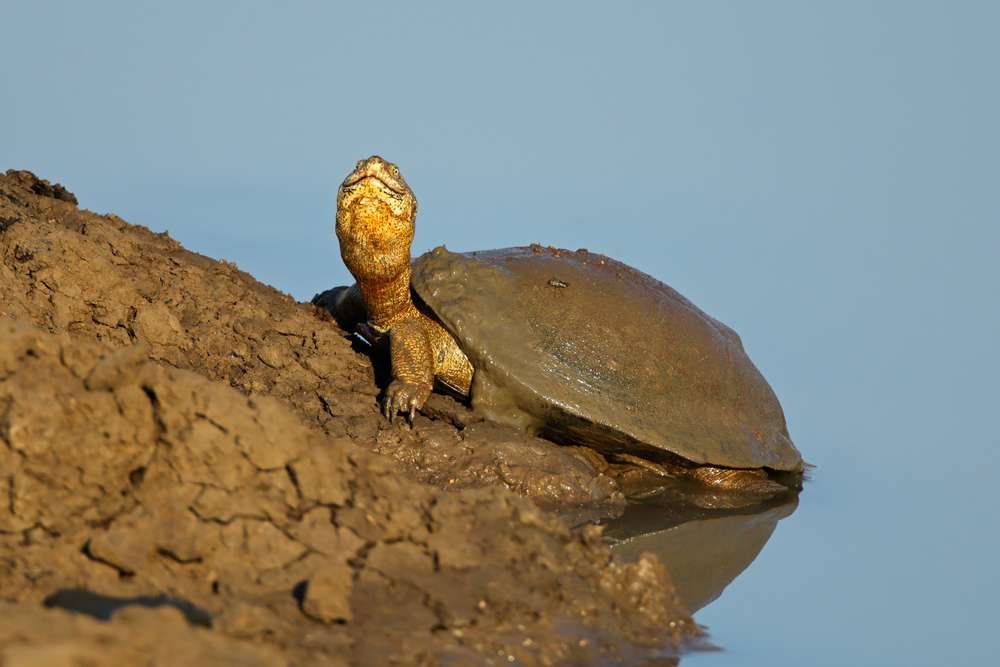African Helmeted Turtle
( Marsh terrapin, crocodile turtle or African side-necked turtle )
- Pelomedusa subrufa
- IUCN Status: Least Concern
- Threat: harmless
- Venom/Toxin: none
- Trend: decreasing

- Phylum: Chordata
- Class: Reptilia
- Order: Testudines
- Suborder: Pleurodira
- Family: Pelomedusidae
- Genus: Pelomedusa
Share:
General Information
The African helmeted turtle is a small turtle that has a shell that looks just like an old military helmet. It is a common house pet for many turtle lovers.
Fun Facts!
Unlike many turtles, the African helmeted turtle is able, when it finds itself upside down, to right itself with a vigorous flick of its long muscular neck. Turtles and Tortoises are known to be highly intelligent. They can dig under or plan their escape from captivity, they can learn new tricks and remember them for a very long time. Another interesting feature is that they have both an exoskeleton (the shell on the outside) and an endo-skeleton (the bones on the inside). The African helmeted turtle have a relationship with African buffalo, rhinos, and warthogs. These animals seek the African helmeted turtles out and have them help remove ticks, flies and other parasites from their bodies.
Description
The marsh terrapin is typically a small turtle. The top of the tail and limbs are a grayish brown, while the underside is yellowish. The male turtle is distinguished by its long, thick tail. A female tends to have a shorter tail and a broader carapace.
- Length: less than 32.5 cm
Ecology and Behaviour
The African helmeted turtle will often leave water bodies and embark on long overland journeys. During exceptionally dry weather when water bodies dry up, it will typically dig into the ground and bury itself until rains return; it has been known to spend months or even years in such a state. It will also hibernate during very cold weather, and aestivate during unusually hot, dry weather
Diet
The African helmeted turtle is an omnivore and will eat almost anything. The fine claws on its feet help it tear its prey apart. Groups of African Helmeted turtles have been observed capturing and drowning larger prey such as doves that come to drink and the commotion caused by these group attacks is often mistaken for crocodiles. All food is taken underwater to be eaten. This is why they have earned the nickname of, crocodile turtle
Reproduction
Courtship happens all year round. The male will follow the female, nodding his head in front of hers. If she is not responsive, she will nip and snap and walk away. If she is willing, she responds by nodding her head or just standing still, so he can mount her. While mating, each of the turtles shakes its head.
The female will lay two to ten eggs on average, normally during late spring and early summer. The eggs are placed in a flask-shaped nest about 10 to 18 cm deep. The eggs hatch in 75– 90 days
Conservation
It is categorized by the International Union for Conservation of Nature (IUCN) as, ” Least Concern “
Distribution and Habitat
The geographic range of the Marsh terrapin covers a large portion of Africa. It is a semi-aquatic animal, which prefers living in standing water, such as marshes, swamps, pans, dams, lakes and it also occupies rain pools and places that are fertilized. To a lesser extent, it can also be found along rivers.
Interaction with humans
The African side-necked turtle is popular as a pet because of its unusual head tucking behavior. Currently it is mainly threatened by widespread collection from the wild for the illegal international trade in the species. It is also collected by local peoples for food and human population growth in the area is putting pressure on the species. Human-induced fire is also a threat. In most Zambian cultures, turtles and tortoises are revered and respected by people. It is said that one should never kill a turtle or tortoise without reason. If you are to come across one stuck upside down along your path, it is said to be good luck to help it and turn it over to let it goon its way and that doing the opposite or leaving it stuck is very bad luck and karma.
No donation to this project yet.
| M | T | W | T | F | S | S |
|---|---|---|---|---|---|---|
| 1 | 2 | 3 | 4 | 5 | 6 | 7 |
| 8 | 9 | 10 | 11 | 12 | 13 | 14 |
| 15 | 16 | 17 | 18 | 19 | 20 | 21 |
| 22 | 23 | 24 | 25 | 26 | 27 | 28 |
| 29 | 30 | 31 | ||||


